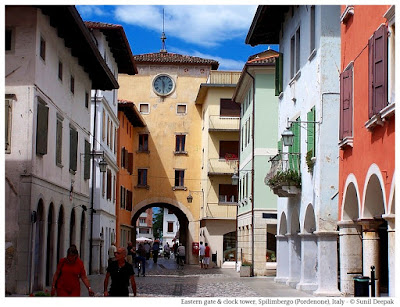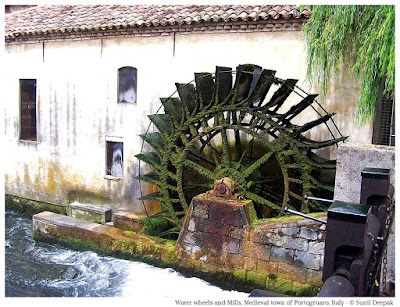If you ask someone in Rome about where can you find some angels, probably they will advise you to go the
Ponte Degli Angeli (the Angel Bridge) near
Castel Sant'Angelo, in front of the St. Peter's square in the
Vatican.
It is true. Ponte Degli Angeli has a lot of Angels. However, I don't find those statues very exciting. They all look very similar to me. There is another place in Rome where you can find a diversity of angels - at the
Verano cemetery. It is full of sculptures and some of them are amazing. It is a free open air museum in the centre of the city. So come and join me in a mini-tour of Verano cemetry, looking for its most beautiful angels.
This post presents my ten favourite sculptures of Angels from Verano. The first image (above) has a boy angel, which is a rarity because most sculptures and paintings show angels as young women or children.
The angel of this image is an adolescent boy, his face still innocent. He looks slightly sad, his gaze far away, mildly curious. In his right hand he is carrying the symbol of Roman republic (SPQR) while his left hand holds the knob of a sword. He is wearing the belt of a warrior. Usually angels are shown in gestures of peace, so this angel is unusual. This sculpture is part of a Marine monument. I love the touch of green moss on the boy's face and wings.
ANGELS & OTHER CELESTIAL BEINGS
The word "Angel" comes from Greek "Angelos", meaning the messenger of gods. The ancient Sumerian culture in Mesopotamia 4000 years ago had angels as the messengers between the divine world and human world, and also as the guardian-souls looking after and protecting individuals. Zoroastrian cosmology also included the concept of guardian angels.
The monotheistic religions born in the middle east, especially Christianity, inherited these Pagan concepts of Sumerian and Zoroastrian angels and wove them in their own sacred books and mythologies. Old Testament and New Testament both mention Gabriel as the divine messenger angel. The New Testament has a whole world of these divine creatures including Angels, Archangels, Cherubs, etc. who play divine music and help the dying persons to pass into the other world.
Artists, both painters and sculptors, made the angels more ubiquitous by including them in their works, especially in paintings on the Christian religious themes. Some people celebrate 2 October as the "Guardian Angel day".
Some recent American/European TV serials and films are about guardian angels helping people in need, in which both men and women are shown as angels. However sculptures and paintings of adult male angels are less common (except as "Angel of Death").
On the other hand, the child angels are often shown without any genitals and are more common in the paintings than in sculptures. Therefore the word angelic is often used in the sense of sexual innocence. I don't know if Freud ever gave any interpretation about the meaning and significance of these asexual angels.
Angels and Indian Mythology: In India, I had grown up with concepts of Apsara and Pari from the Indian mythology. I understood "Apsara" as beautiful celestial women who were sometimes brought to earth by the Gods, especially to create diversions for the sages (Rishi). The Apasara did not have wings. On the other hand, Pari were magical female figures with wings who could fulfill wishes. There was no concept similar to that of an angle in my childhood mythological stories.
Indian mythology has the concept of messengers of the celestial world. For example, there is Narad Muni, usually shown as an old man wearing orange clothes who has magic sandals so that he can travel where ever we wants. However, even these messengers of Indian mythology are different from the common images of angels. Another divine messaging device in Indian mythology is "Akashvani" or the voice from the sky. For example, before Krishna's birth, his uncle hears the Akashvani that the son of his sister will kill him one day.
VERANO CEMETERY OF ROME
Often friends ask advice about visiting some places that are not yet discovered by tourists. Rome has many such places, if you have a little patience to search for them. Verano cemetery is one such place where very few tourists ever arrive.
"Isn't that a kind of morbid, visiting a cemetery?" You can ask.
The old cemeteries are like open air museums. They have sculptures, historical buildings and sometimes even archaeological areas. Verano cemetery is not very old - it was instituted only in the 1800s.
Verano cemetery is located near the Tiburtina railway station, close to Sapienza university in Rome. The nearest metro station is Policlinico (on Metro B), from where you can walk or take a tram (3, 19) and get down at Verano (3 stops from Policlinico).
Verano cemetery is huge and includes different hills. So remember to wear comfortable shoes and carry some water with you. It will be a rewarding but also, a long and tiring walk.
The cemetery has the tombs of some of the most
famous Italians - actors, writers and politicians including Vittorio de Sica, Vittorio Gassman, Marcello Mastroianni, Alberto Moravia, Roberto Rossellini and Bud Spencer. If you are interested in looking for the tombs of the famous, there are guided tours for the visitors, especially on the weekends.
ANGELS OF VERANO
The angels of Verano can be broadly divided into three groups - the first and the biggest group of Angels has female figures expressing sadness; the second group has adult female figures with other expressions such as peace; and the rare third group, which has child angels.
Let me start with three images of sculptures showing angels shown as adolescent girl or women, expressing sadness and loss. These angels express the feelings of bereavement of the family members.
In all the three sculptures I love the way rain, snow, wind and sun can leave their own marks on the stones. I feel that the discolorations and the moss can bring alive the stones.
The next angel has some artificial greenish-blue leaves flowing down from the basket in her hands. She does not seem sad to me, rather she seems detached, looking at the future awaiting her in the other world.
The next angel is from a military monument. She seems more like an Olympian athlete who is declaring her power and rejoicing in her win. Her wings seem like swords or shields grouped together, softened by the moss. She evokes strong and contradictory feelings in me, not all of them pleasant. I have included this sculpture because of its ability to provoke and unsettle.
The next sculpture of angel seems to express love and desire. She makes me think of a Juliet who is finally going to meet her Romeo after a long wait. Her face is dreamy and her features are soft. She seems to symbolise hope and love rather than the pain of a separation.
The eight sculpture seems to be from Bible, an angel telling Mary that God was going to come to her womb. This angel is a young girl with short hair, she seems to be modelled on some real person. Her right arm is raised, her hands partially open and she seems to saying something. I love her earnest expression and, the white and dark mottling on this sculpture caused by the rains. She makes me think of a nice school teacher talking to small children.
The ninth sculpture of angel is sitting on the tomb and is looking intently at a long scroll, as if reading about the good and bad deeds of the person. Thus, this angel is more like a judgement angel who is going to decide the fate of the person. So she is a working angel, having a specific and difficult role.
The tenth and last image of this post has three child angels, also called cherubs. Cherubs are chubby, beautiful and innocent looking angels usually shown in religious paintings, especially around the figure of Madonna.
This particular sculpture is different since it seems to tell a story - a sad looking baby angel is standing behind a tomb while other two baby angels are talking to him, as if telling him to not to worry and that he will be fine in the new world of angels. Probably this tomb belonged to a baby boy. I love the expressions of the baby angels and their tiny little wings.
CONCLUSIONS
Angels are ubiquitous in Rome. There is even a bridge full of angels (Ponte degli Angeli). But the angels in the old part of the Verano cemetery are special. The background of the cemetery with its old decaying graves, stones covered with moss, sculptures eroded by time, they all make these angels come alive.
I love these sculptures because they touch on the most fundamental of human emotions - sadness, loneliness, bereavement and peace. If you think of art as a way of understanding and experiencing human emotions, you can understand why I see so much beauty in them.
Verano is not just about angels. It has lot of other sculptures too.
I hope that if you ever come to visit Rome these images will stimulate you to think of visiting Verano cemetery. It is a magical place and afterwards you can tell your friends that you have visited a place seen by very few tourists.
When we say "angels" you somehow imagine them to be all similar. As these images show, the sculptures of angels are expressing the different human emotions felt by bereaved families and there can be so much to see, understand and appreciate in their diversity.
BTW, does the city of Los Angels has any beautiful sculptures of angels?
***




























































